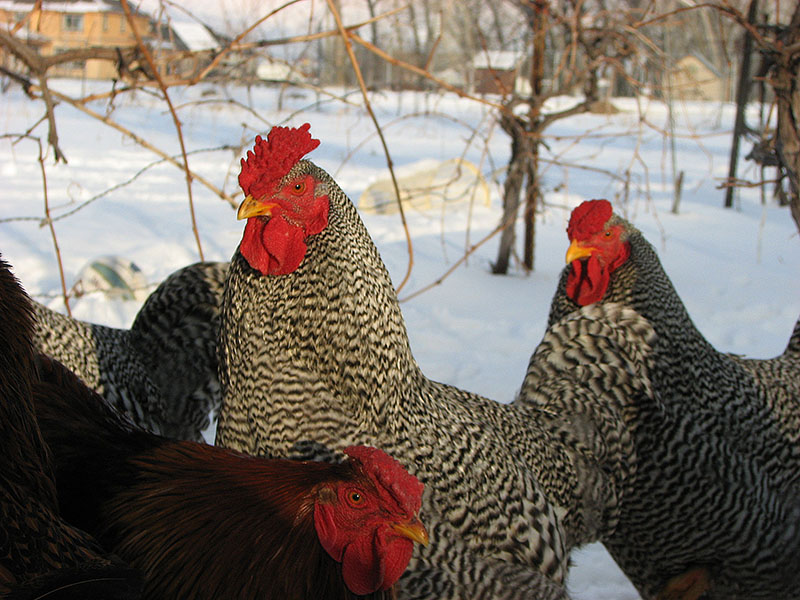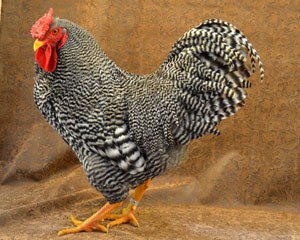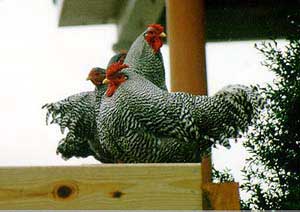Dominiques Chickens
 The Dominique breed was developed in New England from the fowl in the area. These
were of the type predominating in the south of England and from which the Sussex and
Dorking descended. The breed was generally known as Dominique except in the region
of origin where they were known as Plymouth Rock and occasionally as Pilgrim Fowls.
The differentiation between Plymouth Rock and Dominique was not made until 1870 when
the management of the New York state poultry show ruled that only rose combed fowl
of intermediate size could compete as Dominiques, and that all medium and large single
combed fowl of this color would be known as Plymouth Rocks. A small single combed
bird of this color was called a Dominique Leghorn. A great increase in popular interest
began in 1875 with the "improved" type finding an enthusiastic response among exhibitors
and farmers. The breed was never used commercially, and was eventually eclipsed on
the farm by the gradual shift to "Plymouth Rocks" when the preferred type of "Dominique"
had been transformed into the "Plymouth Rock."
The Dominique breed was developed in New England from the fowl in the area. These
were of the type predominating in the south of England and from which the Sussex and
Dorking descended. The breed was generally known as Dominique except in the region
of origin where they were known as Plymouth Rock and occasionally as Pilgrim Fowls.
The differentiation between Plymouth Rock and Dominique was not made until 1870 when
the management of the New York state poultry show ruled that only rose combed fowl
of intermediate size could compete as Dominiques, and that all medium and large single
combed fowl of this color would be known as Plymouth Rocks. A small single combed
bird of this color was called a Dominique Leghorn. A great increase in popular interest
began in 1875 with the "improved" type finding an enthusiastic response among exhibitors
and farmers. The breed was never used commercially, and was eventually eclipsed on
the farm by the gradual shift to "Plymouth Rocks" when the preferred type of "Dominique"
had been transformed into the "Plymouth Rock."
Characteristics
 The Dominique have many advantages besides their handsome appearance. They are hardy,
do well on open range as well as in confinement, are generally calm by nature and
are easy to work with and show. They hatch well, feather early, mature young, and
are of moderate size. The females are good mothers, reasonably good layers of light
to dark brown, and show less tendency toward broodiness than many other exhibition
breeds. There are both large and bantam Dominiques. The Dominique is a medium sized
bird with black and white barring over the entire body. The rose comb is characteristic.
The heavy plumage not only protected the birds in cold weather, but provided material
for pillows and featherbeds. The plumage coloration also made them less conspicuous
to predators. They were expected to make a part of their living by foraging and to
raise a clutch or two of chicks each year.
The Dominique have many advantages besides their handsome appearance. They are hardy,
do well on open range as well as in confinement, are generally calm by nature and
are easy to work with and show. They hatch well, feather early, mature young, and
are of moderate size. The females are good mothers, reasonably good layers of light
to dark brown, and show less tendency toward broodiness than many other exhibition
breeds. There are both large and bantam Dominiques. The Dominique is a medium sized
bird with black and white barring over the entire body. The rose comb is characteristic.
The heavy plumage not only protected the birds in cold weather, but provided material
for pillows and featherbeds. The plumage coloration also made them less conspicuous
to predators. They were expected to make a part of their living by foraging and to
raise a clutch or two of chicks each year.
Standard Weights
Cock: 7 lbs
Hen: 5 lbs
Bantam Cock: 28 oz
Bantam Hen: 24 oz
Varieties
 None (According to the APA)
None (According to the APA)
Egg Shell Color
Brown.
Uses
A dual-purpose breed, these birds were kept to produce brown eggs and meat. The Dominique is expected to lay around 100-150 eggs per year, dependent on the surrounding condition; for example, the weather or the level of comfort for the hen.
Status
While for many years the Dominique were very rare, they are no longer a "lost breed." There has recently been a revival of interest in them which has placed them in a unique category of their being uncommon enough to be interesting and unusual, but not so common as to be a "me, too" breed.
Additional information
References
The American Livestock Breeds Conservancy, Box 477, Pittsboro, NC 27312
"Dominique Chicken." The Livestock Conservancy. The Livestock Conservancy, n.d. Web. 24 June 2015.
Ekarius, Carol. "Chickens: Dominique." Pocketful of Poultry: Chickens, Ducks, Geese, Turkeys. North Adams, MA: Storey Pub., 2007. 64-65. Print.
Lewis, Celia. "Breed Profiles: Dominique." The Illustrated Guide to Chickens: How to Choose Them, How to Keep Them. New York: Skyhorse Pub., 2011. 82. Print.
